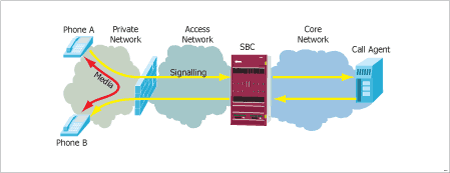
Anti-tromboning
Encyclopedia

Anti-tromboning is a feature employed in telecommunication networks, such as voice over IP
Voice over IP
Voice over Internet Protocol is a family of technologies, methodologies, communication protocols, and transmission techniques for the delivery of voice communications and multimedia sessions over Internet Protocol networks, such as the Internet...
networks, that optimises the use of the access network and reduces excess processing and traffic. A network border node, such as a Session Border Controller
Session Border Controller
A session border controller is a device regularly deployed in Voice over Internet Protocol networks to exert control over the signaling and usually also the media streams involved in setting up, conducting, and tearing down telephone calls or other interactive media communications.SBC's original...
, handling calls as they pass from the access network to the core network can examine the IP address
IP address
An Internet Protocol address is a numerical label assigned to each device participating in a computer network that uses the Internet Protocol for communication. An IP address serves two principal functions: host or network interface identification and location addressing...
or domains of both the caller and called parties and if they reside in the same part of the network the media path can be released allowing media to flow directly between the two parties without entering the access network. The benefits of this action are twofold: 1) the caller is not paying for any bandwidth usage on the carrier network (but may be arbitrarily paying for the carrier's handoff service) and 2) The carrier's network is less congested.
In mobile networks servicing a large number of geographically dense peers, any two peers who wish to communicate between one-another may exchange their media data through a separate path that exploits localised and lower-power transmission, as a form of sub-band signalling. This extends into situations where bulk data can be sent over a less reliable but higher bandwidth capacity and cheaper cost/latency link, whilst parity data for reconstructing bad packets or supporting determinancy in fuzzy-state weakly determined data can be sent over more reliable but lower bandwidth capacity and expensive cost/latency link.
The session and control data can be completely decentralised, removing the Tromboned line altogether, under a suitable multiple-input multiple-output MIMO
MIMO
In radio, multiple-input and multiple-output, or MIMO , is the use of multiple antennas at both the transmitter and receiver to improve communication performance. It is one of several forms of smart antenna technology...
network system. In this case, the aggregate media and session control data may be distributed across the network in a dynamic best-possible solution form that meets the link criteria of both the individual peer and the constraints of the network infrastructure (other peers, basestations, etc.), which may vary between each individual peers. A subscription service may primarily support paying members, but allocate a certain amount of under-utilised bandwidth to provide longhaul access to non-paying members, with the assumption that these members will in turn provide paying members with traversal of bulk media data within a geographical area, or even high-latency propagation across cells. The lowered cost to the service provider that results from resource sharing is the economic rationale for these network provision schemes.

